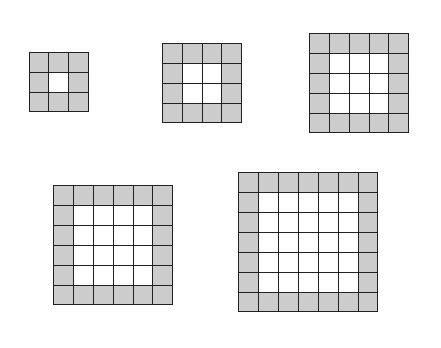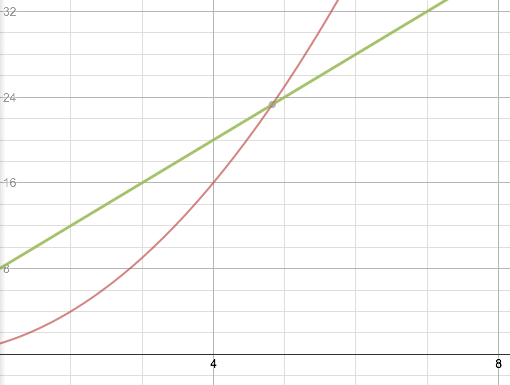My principal came up to me the other day and told me that he just had one of the strangest conversations he’s ever had in education. A few girls from my class had just excitedly shared with him that they were on fire with math. He’s more of a language arts enthusiast, and I guess he had never seen the glow from anyone who has just glimpsed some underlying order, just uncovered something mystical, something deep and hidden in numbers. It’s pretty awesome when that happens. Our class, and these girls in particular have been having a really good time discovering these patterns. First in the sequences of tiles or blocks, then through the distances between the numbers and the rates of change, and finally on the coordinate plane. It’s a wonderful thing to connect a physical model, the ordered pairs that describe it, and a graph – it’s practically poetry.
Below is the “pool” sequence. The gray tiles are the border and the white tiles are the surface area of the water in the pool.
 This was one of the first sequences we looked at. Not the first mind you, but it surprised me how soon we got into functions that were non-linear. Actually, this non-linear function was easier for the kids to decode than the linear one that accompanied it. First students shared their observations:
This was one of the first sequences we looked at. Not the first mind you, but it surprised me how soon we got into functions that were non-linear. Actually, this non-linear function was easier for the kids to decode than the linear one that accompanied it. First students shared their observations:
- The water gets bigger by 3 (the first time)
- Next it goes up by 5
- Pool area goes up by increasing odd numbers (+1, +3, +5…)
- Pool area is 1×1, 2×2, 3×3…
- Odd arrangements have a center tile
- Sides of the pool get bigger by 1
- Arrangement number is 2 less than side length
- Pool and border expand at different constant [sic] rates
- Arrangement 1 fits into the “white” of arrangement 3
- It looks like arrangement 3 fits into 5’s pool
- All odd arrangements fit into next odd ‘s white
Next we looked at the patterns that happen in the numbers. Below is a table of arrangement numbers (x), the number of border tiles (y), and some other observations.
| Arrangement (x) | Pool Border (y) | Observations | Rule? |
|---|---|---|---|
| 1 | 8 | 5x + 3 | |
| 2 | 12 | +4 | 5x + 2 |
| 3 | 16 | +4 | 5x + 1 |
| 4 | 20 | +4 | 5x + 0 |
| 5 | 24 | +4 | 5x - 1 |
One student got really excited to see her pattern continue indefinitely. We looked back at the tile models to see how we could “see” the growth by 4 that shows up in the table. This yielded some really neat connections (and I think we came to a more formal rule). Next came the data for the water tiles. This one was snatched up easily, but the significance of our departure from linear relationships was not clear until we examined the graph.
| Arrangement (x) | Pool Area (y) | Observations | Rule? |
|---|---|---|---|
| 1 | 1 | x * x | |
| 2 | 4 | +3 | x * x |
| 3 | 9 | +5 | x * x |
| 4 | 16 | +7 | x * x |
| 5 | 25 | +9 | x * x |
Up until now, students had been seeing even steps – constant rates of change. Our outputs had always gone up by the same amount in each iteration of the sequence. With the pool area, each subsequent arrangement was significantly larger than the previous. The steps (up the y-axis) were getting increasingly tall.
The green line is the graph of the border and the red line is the graph of the pool area.
 After putting all of this together, students were able to make predictions about how many tiles would be in some distant arrangement, and even find out which arrangement would have a certain number of tiles. Try it out for yourself!
After putting all of this together, students were able to make predictions about how many tiles would be in some distant arrangement, and even find out which arrangement would have a certain number of tiles. Try it out for yourself!
1. How many border tiles will be in any arrangement? How many pool tiles will be in any arrangement?
2. Which arrangement will have 196 tiles total for both border and pool?*
*I can’t say if my 5th graders solved this one yet… we’ll have to come back to this after spring break.